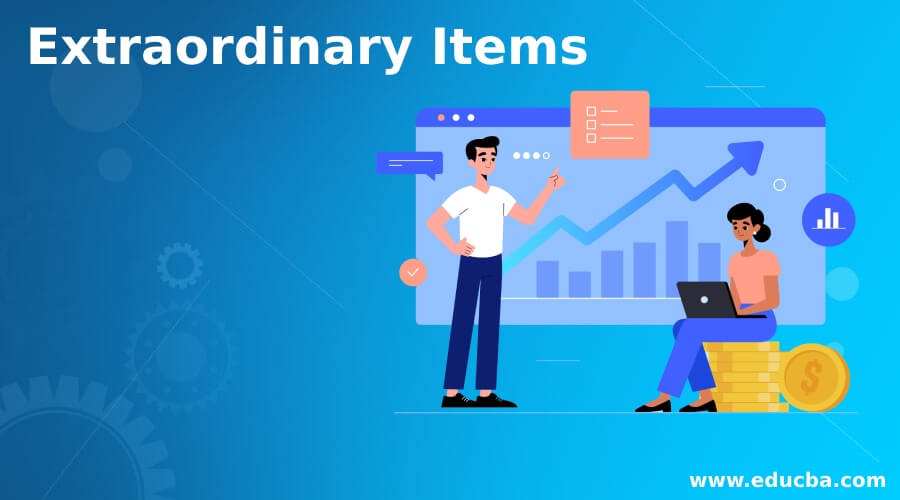Updated July 19, 2023

Definition of Extraordinary Items
Extraordinary Items are the transactions or events that are a rare occurrence in the business organization but have a material value & effect on the profit & loss of the organization for the period of occurrence and the effect of the same on the profit & loss statement are shown separately in the financial statements of the organization.
Explanation
Certain events sometimes occur in the business organization that is not related to day-to-day business operations; instead, they are not frequent and unusual but prove material to the profit & loss derived by the organization during that period of occurrence. These items & events are shown separately in the company’s financials and are termed ‘Extraordinary Items.’ These extraordinary events could prove to be profitable for the business by boosting the profit of that period or even could prove liability for the company as it could result in decreasing the profit of that period or increasing the loss of that period.
Features of Extraordinary Items
When presenting extraordinary items individually in a company’s financials, they may exhibit some of the following characteristics:
1. Events Should Be Separate, Unusual & Infrequent in Nature
The main & highlighting feature and characteristics of the extraordinary items are the unusual and infrequent occurrence of the transaction. These transactions are unanticipated and only happen occasionally.
2. Events and Transactions are Material in Nature
The Materiality characteristics of the event are one of the mandatory features. The materiality of the transaction qualifies the transaction to be highlighted in the entity’s financial statement as a separate point because of the material effect of the same in the profit & loss made by the company for the relevant period. The same need to be communicated to the users of the financial statement for an accurate & fair view of the relevant facts.
Examples of Extraordinary Items
The following are some of the events that could be considered extraordinary items in most business organizations:
- Losses experienced by the business organization due to natural hazards or natural calamities like earthquakes or floods etc.
- Losses experienced by the business organization due to un-precedential cessation of business operation due to sudden strikes by the employees or labor forces.
- A gain arising from the sale of non-performing units or parts of the business organization results in a sudden increase in the profit arising in the business, which is not a common day trading or transaction within the business etc.
Interpretation of Extraordinary Items
Extraordinary items are non-recurring transactions that do not occur frequently during the business. These events or transactions have a material impact on the company’s financials during the occurrence. These are mentioned or represented separately because it shows the financial statement users that the unusual increase or decrease in usual profit or loss in the business is due to some unprecedented transactions that occur during the period, which does not happen frequently. Hence the unusual profit & loss figure arising from the effect of extraordinary items is a one-time thing and should not be thought of as a change in profit and loss arising from the day-to-day business activities.
Disclosure of Extraordinary Items
In earlier days, till 2015, the extraordinary items were to be disclosed in the Profit & Loss statement of the organization just after the calculation of profit & loss arising from the day-to-day running of the business and the net impact on the profit & loss for that period is evaluated. Still, the presentation of the same in the front of the income statement does not change anything.
Importance of Extraordinary Items
- The disclosure of exceptional items shows the accurate & fair presentation of the financial statements of the company and helps the company to comply with the statutory rules & regulations.
- The presentation of the extraordinary items separately does not provide a confusing record of the status of the running of the business. In case of loss arising from the extraordinary items, the presentation of the same separately helps the company to show that there is nothing wrong with the normal running course of the business. Still, the extraordinary event was the reason for the loss.
- The separate presentation of the extraordinary items helps evaluate the same while calculating the company’s tax liability. It takes the effects of the extraordinary items in evaluating the tax payable by the company for the same period.
Advantages of Extraordinary Items
There is an immense advantage to the company for presenting extraordinary events or items separately in the financial statement.
- In case of loss arising from the extraordinary event, the separate presentation of the same saves the impact of the same in the normal figure of the business in its financial statements. It prevents the reputation or goodwill of the company from any downfall in the image of the company in such a competitive market.
- The presentation of the extraordinary items separately puts the focus on the profit & loss of the business in the next accounting period, as the actual impact of the extraordinary event on the normal course of business activities could be seen in the following period, which determines the reactions of the users of the financial statement of the company.
Conclusion
The extraordinary event could have a material impact on the financials of the business and could have a very negative impact on the normal running course of the business. The destruction of the company’s factory due to any natural hazards could put a question on the going concern of the business for the same period or the following period. Hence, presenting extraordinary events with full information is important for the government and all the users of the company’s financial statements.
Recommended Articles
We hope that this EDUCBA information on “Extraordinary Items” was beneficial to you. You can view EDUCBA’s recommended articles for more information.

